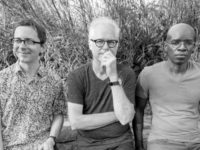My creative writing teacher in college drilled into us the mantra “show don’t tell.” Don’t tell people your character is heartbroken. Show them. Don’t tell your readers that your character is sneaking into a room. Show them that he is insinuating himself there. The difference is between the product and the process. To extend the metaphor to music, rock wants to wow you with the end result, and jazz is about getting there.
My journey through jazz has been odd and, at times, rough. I dived into it decades ago with a curiosity-driven purchase of Bill Frisell’s Live solely because of a record-company derived proclamation on the outside calling him the “Hendrix of the jazz guitar.” That he was, and it was very nearly too much for these tender ears.
Squawking and honking, squealing and squirming, Frisell’s guitar lines were anything but standard jazz-guitar fare. This was mind-blowing stuff to someone whose music barely reached outside of the many Pearl Jam-alikes around back then. I didn’t listen to it often, and when I did it was rarely for long: It was just too alien sounding. Drummer Joey Baron rarely plays on the beat, often just skittering about on the rims of his drums, placing well-timed thumps with his kick drum and splashing about on his cymbals. Bassist Kermit Driscoll bubbles and bobs around, at times mimicking, but not replicating Frisell’s squirrelly guitar lines.
[SOMETHING ELSE! INTERVIEW: Bill Frisell joined us to discuss his terrific John Lennon tribute album, signature career moments and how what he can’t play helped shape his sound.]
Bill Frisell’s music, as represented on Live, is quirky, off-kilter yet infused with a twang akin to bluegrass played at the tempo of ragtime. That he would go on to create modern-day scores for several Buster Keaton movies, or provide music for Gary Larson’s prime-time Far Side cartoon special is no surprise. Serious jazz it is, but it is nothing if not whimsical – which is where Frisell differs so drastically from his contemporaries. It’s not hard to imagine the smile Frisell must often wear while playing, for his music is less about his considerable chops than it is about the pure joy of playing.
The pure joy of playing: This is a fundamental tether between musicians in jazz, especially today. If you play jazz and you don’t do it because you love it – because something inside you makes you play it – you better not be playing it. Jazz simply isn’t going to result in superstardom or great riches anymore, but it remains as something the musician’s musician engages in because nothing else quite satisfies like jazz does.
When you hear a guy like Frisell play, you hear a man at his happiest moment of the day. When you hear a jazz musician play, you are witness to an act of creation, the showing – rather than the re-creation of well-memorized solos and songs. Telling gets you nowhere when it comes to jazz.
I can’t say even to this day that Live quite “makes sense.” My exposure to the album began as a simple exploration of jazz, but I have become a Bill Frisell convert because of it. I know these songs well from their studio counterparts and yet, his studio work, while being some of my favorite jazz albums, fails to conjure the mystery Live does – even now, even after innumerable spins.
That Live continues to show me something every time I listen to it? Very telling.
- King Crimson’s Brief But Important Double-Trio Era Peaked With ‘Thrak’ - April 14, 2025
- How David Bowie’s ‘Reality’ Stood Out For What It Was Not - September 29, 2023
- Metallica’s ‘St. Anger’ Was Always Much Better Than They Said - June 8, 2023



